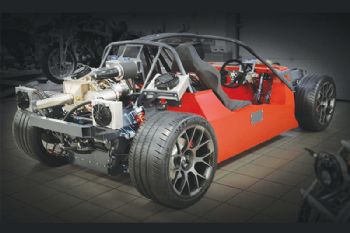
Engineers from the University of Leicester (
www.le.ac.uk) have helped in the development of a new ultra-high-performance range-extended electric sports car — Hipercar.
Standing for High Performance Carbon Reduction, the car is destined for full release in 2019, and will be produced in Somerset by Ariel Motor Co, which also builds the Atom and Nomad cars, as well as the Ace motorcycle.
Hipercar (a model name has yet to be decided) is not just an Ariel Motor Co production car but also a launchpad of UK-developed technology into other niche medium-volume — and ultimately high-volume — automotive production.
The car is a Series Hybrid electric vehicle (drive is only via electric motors) featuring a 750V 42kWh (or 56kWh) lithium-ion cooled and heated battery pack, which is charged, when required, by a 35kW micro-turbine range extender, making the vehicle independent of any charging infrastructure.
A team from the university’s Advanced Structural Dynamics Evaluation Centre (ASDEC) has been closely involved with the project.
Based at MIRA Technology Park, ASDEC is an autonomous testing facility within the University of Leicester, and is the UK’s first commercial 3-D vibration consultancy and modal analysis centre based upon ‘advanced non-contact laser Doppler vibrometry measurements’.
Martin Cockrill, technical specialist at ASDEC, said: “The key to modern vehicle development at every level is computer simulation.
“It is the only way to get the maximum performance out of structures to achieve the requirements of body stiffness for exceptional vehicle dynamics, while minimising weight and ensuring legislative safety requirements are met.
“At ASDEC, we have used the latest in laser based non-contact vibration sensors to avoid needing to attach anything to the surface.
“We have automated the process by mounting these laser systems on a robotic arm, thereby allowing them to be positioned around the structure with pinpoint accuracy, with testing continuing 24/7.
“The resulting data has allowed Ariel to optimise Hipercar’s design and development process.”